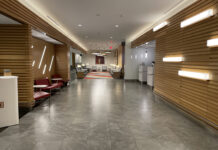TravelingForMiles.com may receive commission from card issuers. Some or all of the card offers that appear on TravelingForMiles.com are from advertisers and may impact how and where card products appear on the site. TravelingForMiles.com does not include all card companies or all available card offers.
Other links to products and travel providers on this website will earn Traveling For Miles a commission that helps contribute to the running of the site. Opinions, reviews, analyses & recommendations are the author’s alone and have not been reviewed, endorsed, or approved by any of these entities. Terms apply to all credit card welcome offers, earning rates and benefits and some credit card benefits will require enrollment. For more details please see the disclosures found at the bottom of every page.
The last time I flew in a regional jet was, I think, on a flight between Las Vegas and Palm Springs, and it was so long ago that the iPhone hadn’t been invented, social media hadn’t ruined the world, and you could still switch on the TV without being assaulted by the gormless faces of talentless nobodies participating in ‘reality TV’.
In fact, it was so long ago that I had almost completely forgotten what the experience was like, and that’s why I was looking forward to my American Airlines CRJ-700ER flight between Palm Springs and Phoenix.
Palm Springs airport (PSP)
Palm Springs airport is one of the smaller airports that I’ve visited and during the low season (the hot summer months), the airport can be beautifully quiet.
I had checked in online the day before I was due to travel, but because I was traveling with golf clubs and a large bag, I still had to head to the check-in desks before making my way to security screening.
There was no one ahead of me in line at the check-in desks so I was soon parted from my club and luggage and on my way.
The airport offers security lanes for TSA Precheck and Clear …
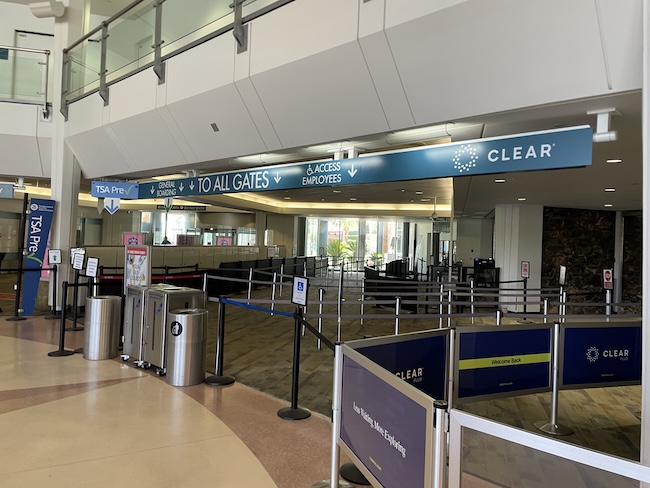
… but for a mid-day flight in the middle of summer, the standard security lines are almost as quick as the expedited lines because there’s no one around.
Once through security you find yourself out in the desert sunshine and faced with the option of a terminal area directly ahead of you (where the larger planes park up), or a second terminal area to the right, where the regional jets park up.
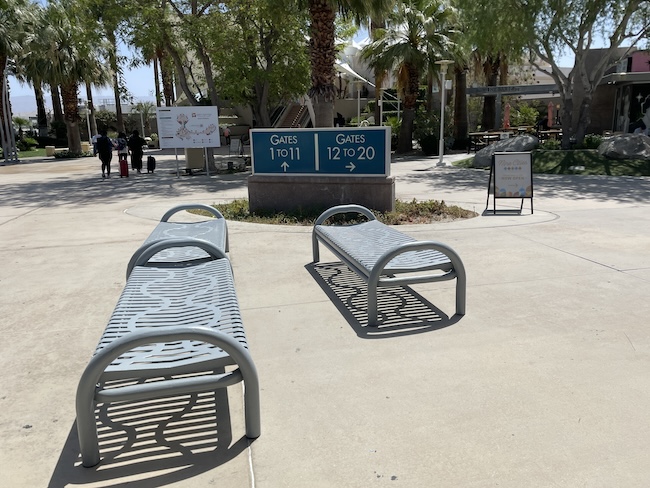
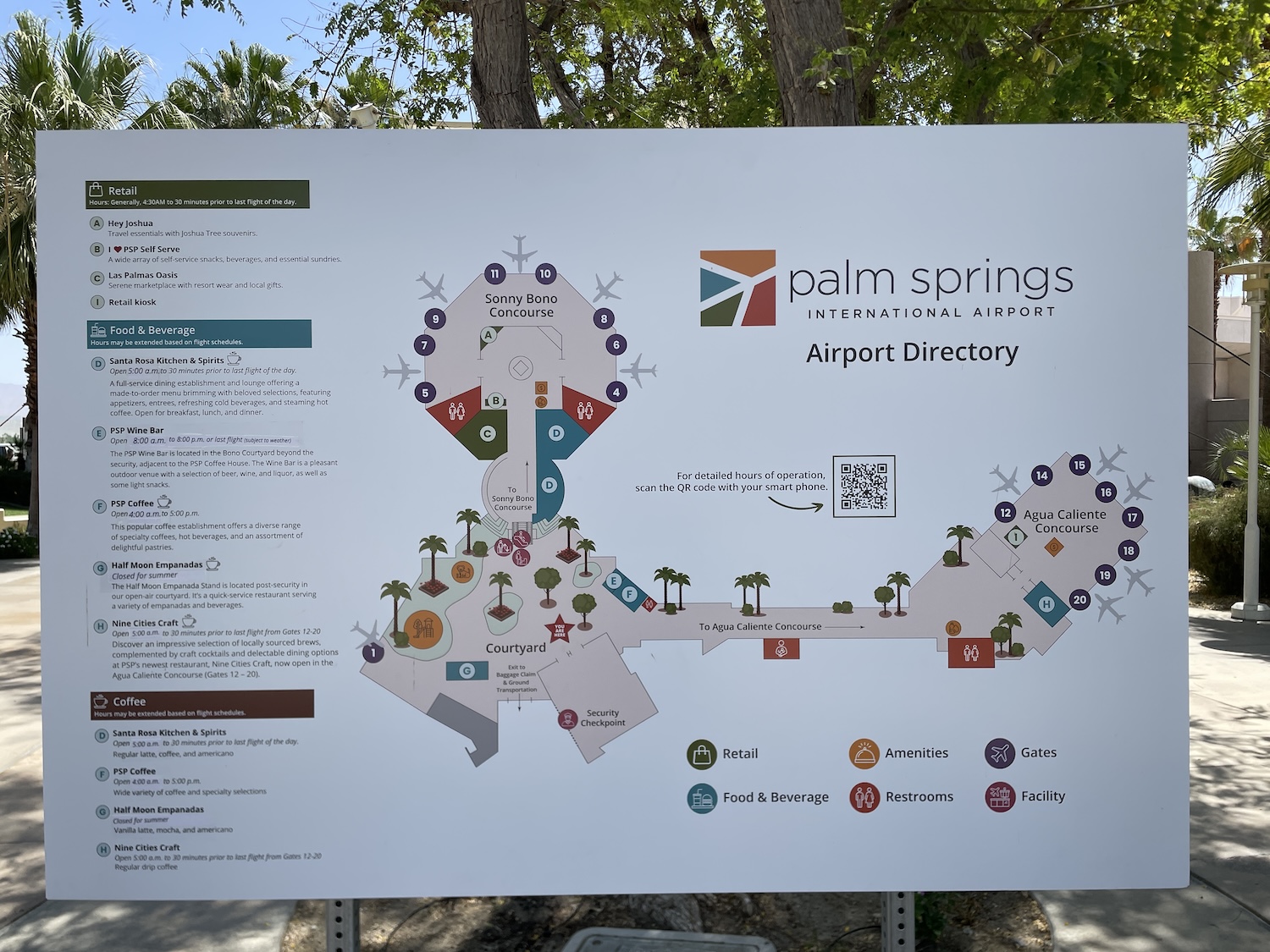
As I was booked to fly on a Bombardier CRJ, I made my way to the right and towards gates 12 – 20.
The regional jet gate areas aren’t going to win any prizes for architectural beauty (nor will the gate areas for the larger aircraft), but they have a lot of seating, they feel spacious, and they offer a respite from the searing heat outside.


A the time of this flight, most of the concessions/shops at the airport were undergoing refurbishment so there wasn’t much on offer.
There was, however, a Nine Cities diner which was open …
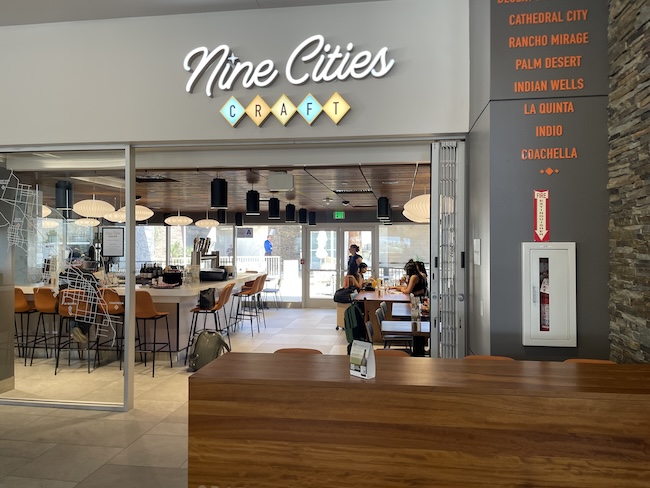


… and there was a temporary stand selling snacks and soft drinks.

Put simply, if you’re traveling through Palm Springs Airport in the next few months, don’t expect to be able to sit down to a gourmet meal before your flight 🙂
The gate experience & boarding
All the gates for the regional jets at Palm Springs airport are at ground level …

… but aside from that, they’re pretty much like most other gates you’ll find around the country.
American Airlines boarding procedures mostly don’t change just because you’re on a small American Eagle aircraft.
As usual, there’s pre-boarding, ConciergeKey boarding, and then groups 1 onwards board. But there is one very key difference that you’ll notice.
In the 30 minutes (or so) before boarding is due to start, the gate agents make frequent announcements reminding flyers that rollaboards will not fit in the overhead bins on a CRJ-700ER.
Customers with rollaboards are asked to step up to the gate to get a bag tag (on which they write their contact details), and just before boarding the aircraft, they hand their bags to the ground crew who then load them into the aircraft hold.

You can watch your regional jet pull up to the gate from the gate area, and when boarding is called, you’re invited to walk out to the aircraft …

… before boarding the plane using a ramp that looks like it’s made from old scaffolding.

The American Eagle CRJ-700ER
The American Airlines/Eagle CRJ-700ER operated by SkyWest can seat up to 65 passengers and offers a 2-2 seating layout in Economy Class and a 1-2 layout in First Class.

The aircraft offers 9 First Class seats, 16 Main Cabin Extra seats, and 40 regular Economy Class seats.
Main Cabin Extra seats offer 35″ of pitch and 3″ of recline, while the regular Economy Class seats offer just 31″ of pitch and also 3″ of recline.
CRJ-700ER First Class cabin
The First Class cabin on the CRJ-700ER features just 9 seats all of which offer 37″ of pitch and 6″ of recline.

This is what the bulkhead seats look like:



This is what the seats in rows 2 and 3 look like:


And this is what the legroom for a regular First Class seat looks like.

Because I came prepared (i.e. I knew how small the overhead bins were going to be), I had no trouble stowing my Briggs and Riley backpack in the overhead bins above the double seats, but a few people had issues and found that they had to hand their bags over to the ground crew who showed them in the hold.


The First Class seat
I had chosen the single seat in row 2 for this flight …

… and this was the view I had when I sat down.

Surprisingly, for a small aircraft like the CRJ-700ER, there’s quite a lot of legroom in the First Class cabin (you get as much legroom here as you do in First Class on a regular American Airlines A321), and while the cabin as a whole feels small and tight, the seats feel fine (keep in mind that I’m 6ft tall and not ‘large’).

That being said, this is a ‘no frills’ First Class seat.
There’s a small ledge on the window-side armrest where a drink can be placed (the double seats share a space on the center armrest) …

The tray table deploys from the armrest and can be partly or fully opened …



… but it’s not particularly sturdy, so expect some ‘bounce’ if you’re typing vigorously on a laptop or if you hit turbulence.
You’ll find a universal AC power outlet and USB-A port to one side and just below the top of the seat cushion …

… and above the seat are two air nozzles (particularly useful when you’re departing from somewhere as hot as Palm Springs), a flight attendant call button (using one of these in a US aircraft is likely to result in you being scolded and then ejected from the aircraft at 28,000 ft), and a couple of reading lights.

Overall, I was surprised at the comfort and the legroom that these seats offer.
Yes, this was a very short flight (~1 hour) and yes, I don’t have weight issues so I don’t need particularly wide seats, but I still think that this is a surprisingly good seat for an aircraft in which some people can barely stand up.
I was expecting to feel ‘squashed in’ and to feel a little confined, but I felt neither of those things. In fact, I was comfortable.
Wifi and entertainment
The American Eagle CRJ-700ER comes equipped with GoGo wifi and for a short hop like this one, American Airlines charges $10 for the whole flight.

I didn’t need to use the wifi on this flight so I can’t tell you how good or bad it is, but I have a poor history with GoGo usage so I would suggest keeping your expectations low to avoid disappointment.
As you have probably already noticed, the American Eagle CRJ-700ER doesn’t offer an inflight entertainment screen (most American Airlines short-haul aircraft don’t), but passengers who have downloaded the American Airlines app in advance can connect to to the airline’s entertainment system through the in-flight wifi for free.


As the information will probably be out of date when you’re reading this, I’m not going to list out what entertainment American was offering on this flight, but you can see what shows and movies are playing onboard right now by visiting this American Airlines webpage.
The service
This will be short and sweet because there really isn’t much to say.
Boarding was efficient, we pushed back on time, we arrived in Phoenix a little ahead of schedule, and there was no major turbulence on the way. That’s good enough for me!
The single flight attendant working the First Class cabin was very friendly, I was served a pre-departure beverages almost as soon as I boarded (choice or water, orange juice and, I think, sparkling wine) …

… and drinks were offered again shortly after we levelled out alongside Biscoff cookies or a packet of peanuts.

What cabin service there was, was performed efficiently and with a smile and who needs more than that on a 60-minute flight?
Overall
Clearly, there’s not much to say about the service or the entertainment on this flight because it was so short, but I was pleasantly surprised at the legroom I had in the First Class seat and at how ‘not confined’ I felt in an aircraft that’s considerably smaller than any other aircraft I’ve flown in over the past 20 years.
Would I fly with American Eagle and in a CRJ-700’s First Class seat again? Sure, why not?
There was absolutely nothing wrong with this experience, and as long as you’re prepared for the fact that any hand baggage larger than a part-filled medium-size backpack will likely have to be placed in the hold, there’s no real reason there should be much wrong with anyone else’s experience either.
All reviews in this series:
Review: American Airlines 777-300ER Business Class (transatlantic)
Review: American Airlines Flagship Lounge at Dallas/Fort Worth (DFW)
Review: American Airlines A321 domestic First Class (DFW-PSP)
Review: Marriott Desert Springs Villas I (a Marriott Vacation Club property)
Review: American Eagle CRJ-700ER First Class (PSP-PHX)
Review: Escape Lounge Phoenix (PHX) Terminal 4
Review: American Airlines 777-200ER Business Class (transatlantic)
Review: Iberia short-haul Business Class A320neo (LHR-MAD)
Review: Iberia Premium Lounge Velazquez Madrid Terminal 4S
Review: Iberia short-haul Economy Class A320neo (MAD-LHR)

















